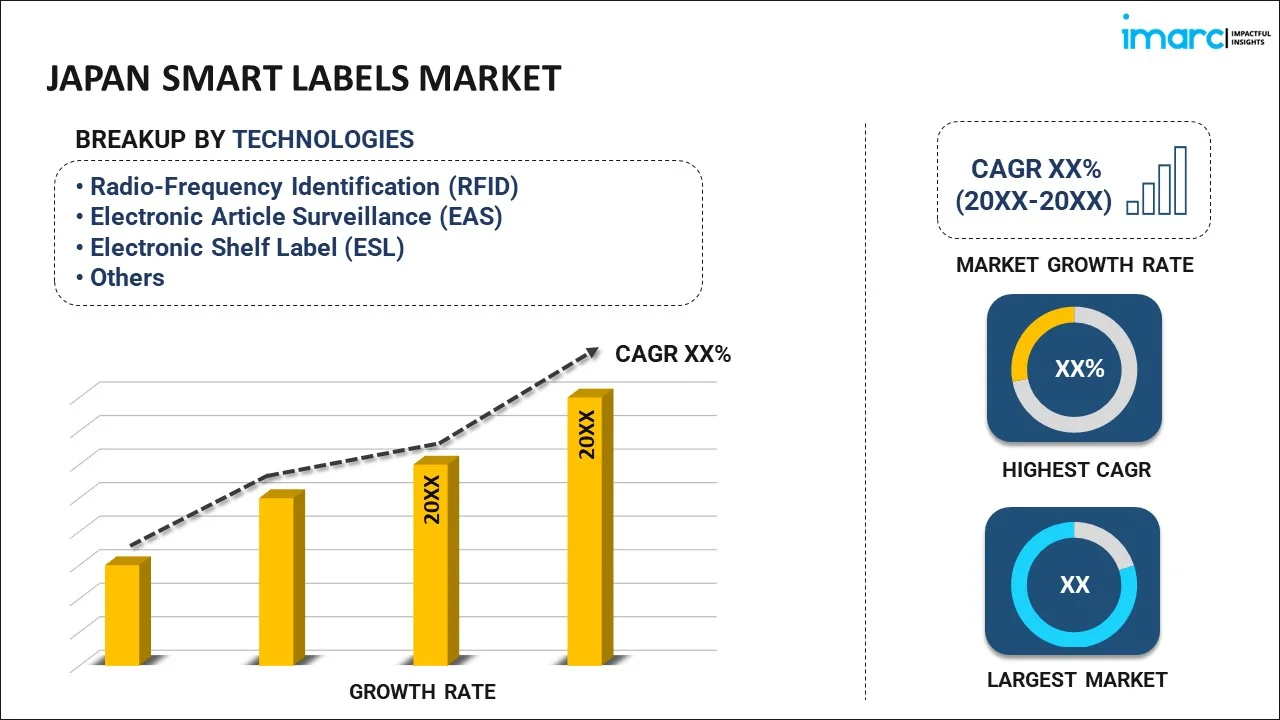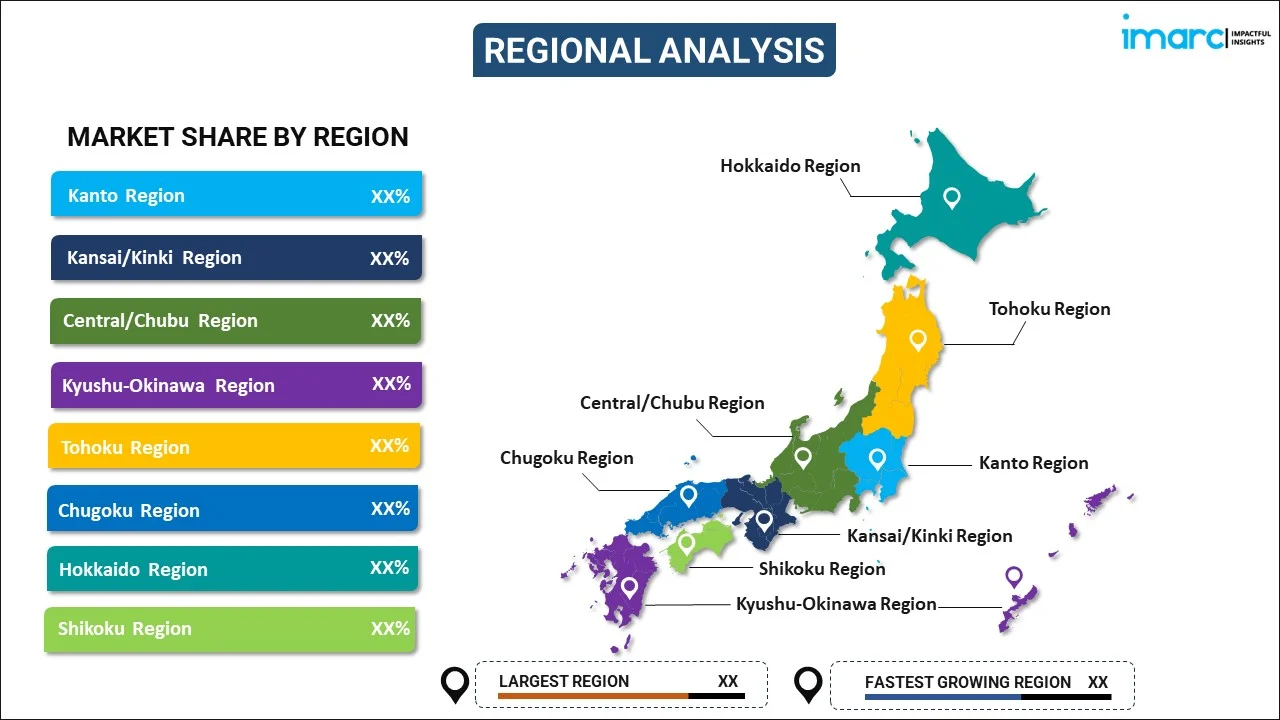
Japan Smart Labels Market Report by Technology (Radio-Frequency Identification (RFID), Electronic Article Surveillance (EAS), Electronic Shelf Label (ESL), Sensing Labels, Near Field Communication (NFC)), Component (Batteries, Transceivers, Microprocessors, Memories, and Others), End User (Retail, Logistics and Transportation, Healthcare, Food and Beverage, Aerospace, Data Centers and Libraries, and Others), and Region 2025-2033
Market Overview:
Japan smart labels market size reached USD 524.6 Million in 2024. Looking forward, IMARC Group expects the market to reach USD 1,904.1 Million by 2033, exhibiting a growth rate (CAGR) of 14.3% during 2025-2033. The market is being driven by a growing demand for the reduction of shoplifting and theft, the rising utilization of the built-in utility in smartphones for QR code scanning, and the increasing awareness among manufacturers.
|
Report Attribute
|
Key Statistics
|
|---|---|
|
Base Year
|
2024
|
|
Forecast Years
|
2025-2033
|
|
Historical Years
|
2019-2024
|
|
Market Size in 2024
|
USD 524.6 Million |
|
Market Forecast in 2033
|
USD 1,904.1 Million |
| Market Growth Rate 2025-2033 | 14.3% |
Smart labels, also referred to as smart tags, are innovative transparent labels equipped with digital technology and designed to work in conjunction with smart devices, allowing consumers to access comprehensive product information. These labels are crafted from materials such as paper, fabrics, or plastics and are available in various forms, including electronic labels, printed labels, or chip labels. They encompass a range of technologies, including radio-frequency identification (RFID), electronic article surveillance (EAS), electronic shelf labels (ESLs), sensing labels, and near field communication (NFC). Smart labels offer numerous advantages, such as automated reading, rapid identification, re-programmability, high durability, and error reduction. They significantly enhance productivity, precision, legibility, and inventory management for manufacturers and are instrumental in tracking products and recording data for effective inventory control. Consequently, smart labels find extensive applications across diverse sectors in Japan, including retail, logistics and transportation, healthcare, automotive, manufacturing, and the food and beverage (F&B) industry.
Japan Smart Labels Market Trends:
The Japan smart labels market is currently experiencing robust growth driven by several key factors. Firstly, there is a surging demand for smart labels in security and tracking solutions, primarily for their effectiveness in reducing instances of shoplifting and theft. This factor is a significant driver bolstering market expansion. Additionally, the increasing awareness among manufacturers about the benefits and applications of smart labels is contributing to the positive outlook of the market. Moreover, the rising demand for smart labels is attributed to their ability to empower consumers to access product information through their preferred methods, including scanning product codes with smartphones or visiting dedicated websites. This convenience-driven adoption is fueling market growth. Furthermore, the built-in utility in smartphones for reading QR codes and accessing information provided by smart labels is creating lucrative opportunities for industry stakeholders. The accuracy and reliability of information delivered by smart labels are also attracting increasing demand and strengthening market growth. Additionally, smart labels are finding growing application in enhancing packaging aesthetics and providing informative content and shipping details on packaged goods, which positively influences market dynamics. The increasing emphasis on environmental sustainability is expected to bolster the regional market in the coming years.
Japan Smart Labels Market Segmentation:
IMARC Group provides an analysis of the key trends in each segment of the market, along with forecasts at the country level for 2025-2033. Our report has categorized the market based on technology, component, and end user.
Technology Insights:

- Radio-Frequency Identification (RFID)
- Electronic Article Surveillance (EAS)
- Electronic Shelf Label (ESL)
- Sensing Labels
- Near Field Communication (NFC)
The report has provided a detailed breakup and analysis of the market based on the technology. This includes radio-frequency identification (RFID), electronic article surveillance (EAS), electronic shelf label (ESL), sensing labels, and near field communication (NFC).
Component Insights:
- Batteries
- Transceivers
- Microprocessors
- Memories
- Others
A detailed breakup and analysis of the market based on the component have also been provided in the report. This includes batteries, transceivers, microprocessors, memories, and others.
End User Insights:
- Retail
- Logistics and Transportation
- Healthcare
- Food and Beverage
- Aerospace
- Data Centers and Libraries
- Others
The report has provided a detailed breakup and analysis of the market based on the end user. This includes retail, logistics and transportation, healthcare, food and beverage, aerospace, data centers and libraries, and others.
Regional Insights:

- Kanto Region
- Kansai/Kinki Region
- Central/ Chubu Region
- Kyushu-Okinawa Region
- Tohoku Region
- Chugoku Region
- Hokkaido Region
- Shikoku Region
The report has also provided a comprehensive analysis of all the major regional markets, which include Kanto Region, Kansai/Kinki Region, Central/ Chubu Region, Kyushu-Okinawa Region, Tohoku Region, Chugoku Region, Hokkaido Region, and Shikoku Region.
Competitive Landscape:
The market research report has also provided a comprehensive analysis of the competitive landscape. Competitive analysis such as market structure, key player positioning, top winning strategies, competitive dashboard, and company evaluation quadrant has been covered in the report. Also, detailed profiles of all major companies have been provided. Some of the key players include:
- Avery Dennison Corporation
- DHL
- Zebra Technologies Corporation
(Please note that this is only a partial list of the key players, and the complete list is provided in the report.)
Japan Smart Labels Market Report Coverage:
| Report Features | Details |
|---|---|
| Base Year of the Analysis | 2024 |
| Historical Period | 2019-2024 |
| Forecast Period | 2025-2033 |
| Units | Million USD |
| Scope of the Report | Exploration of Historical Trends and Market Outlook, Industry Catalysts and Challenges, Segment-Wise Historical and Future Market Assessment:
|
| Technologies Covered | Radio-Frequency Identification (RFID), Electronic Article Surveillance (EAS), Electronic Shelf Label (ESL), Sensing Labels, Near Field Communication (NFC) |
| Components Covered | Batteries, Transceivers, Microprocessors, Memories, Others |
| End Users Covered | Retail, Logistics and Transportation, Healthcare, Food and Beverage, Aerospace, Data Centers and Libraries, Others |
| Regions Covered | Kanto Region, Kansai/Kinki Region, Central/ Chubu Region, Kyushu-Okinawa Region, Tohoku Region, Chugoku Region, Hokkaido Region, Shikoku Region |
| Companies Covered | Avery Dennison Corporation, DHL, Zebra Technologies Corporation, etc. |
| Customization Scope | 10% Free Customization |
| Post-Sale Analyst Support | 10-12 Weeks |
| Delivery Format | PDF and Excel through Email (We can also provide the editable version of the report in PPT/Word format on special request) |
Key Questions Answered in This Report:
- How has the Japan smart labels market performed so far and how will it perform in the coming years?
- What has been the impact of COVID-19 on the Japan smart labels market?
- What is the breakup of the Japan smart labels market on the basis of technology?
- What is the breakup of the Japan smart labels market on the basis of component?
- What is the breakup of the Japan smart labels market on the basis of end user?
- What are the various stages in the value chain of the Japan smart labels market?
- What are the key driving factors and challenges in the Japan smart labels?
- What is the structure of the Japan smart labels market and who are the key players?
- What is the degree of competition in the Japan smart labels market?
Key Benefits for Stakeholders:
- IMARC’s industry report offers a comprehensive quantitative analysis of various market segments, historical and current market trends, market forecasts, and dynamics of the Japan smart labels market from 2019-2033.
- The research report provides the latest information on the market drivers, challenges, and opportunities in the Japan smart labels market.
- Porter's five forces analysis assist stakeholders in assessing the impact of new entrants, competitive rivalry, supplier power, buyer power, and the threat of substitution. It helps stakeholders to analyze the level of competition within the Japan smart labels industry and its attractiveness.
- Competitive landscape allows stakeholders to understand their competitive environment and provides an insight into the current positions of key players in the market.
Need more help?
- Speak to our experienced analysts for insights on the current market scenarios.
- Include additional segments and countries to customize the report as per your requirement.
- Gain an unparalleled competitive advantage in your domain by understanding how to utilize the report and positively impacting your operations and revenue.
- For further assistance, please connect with our analysts.
 Inquire Before Buying
Inquire Before Buying
 Speak to an Analyst
Speak to an Analyst
 Request Brochure
Request Brochure
 Request Customization
Request Customization




.webp)




.webp)












